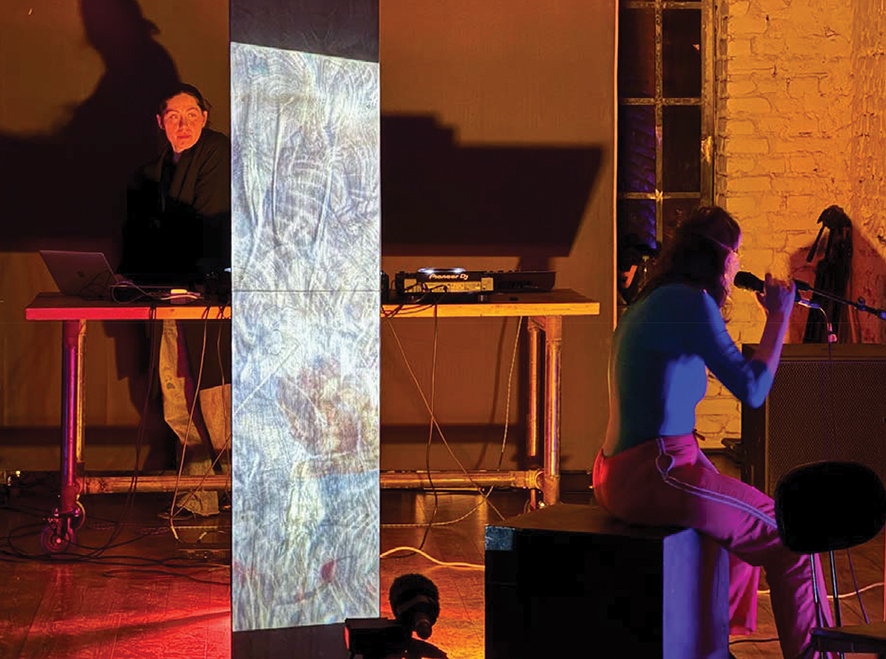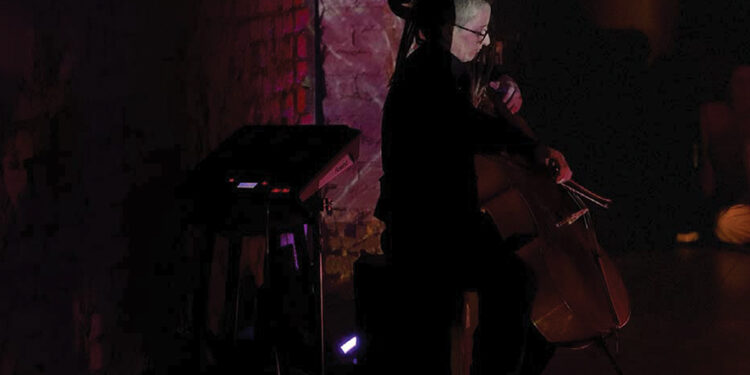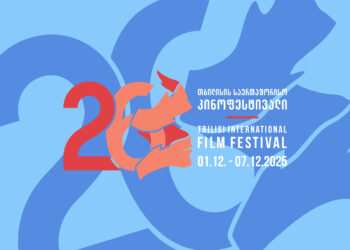On the evening of March 23, Mutant Radio in Tbilisi became the epicenter of a radical reimagination of opera. Homo Freq, an avant-garde collective of musicians and performers, staged an experimental electroacoustic opera that obliterated conventions, distorted expectations, and rewrote the very DNA of operatic storytelling. The event was not merely a concert, but an experience—one that fused electronic manipulation, vocal deconstruction, and a theatrical sense of unpredictability. This interdisciplinary performance explored the barriers that shape human existence—not just physical, but psychological, societal, and perceptual thresholds—through a fusion of sound, movement, and digital art.

Opera, Disfigured and Reborn
Traditional opera thrives on grandeur—lavish orchestration, soaring arias, and an unshakable reliance on narrative conventions. Homo Freq, however, operates on a different frequency, one that dissolves the boundaries between electronic music, voice, and performance art. This collective is not interested in preservation but mutation. Their performance at Mutant Radio was a sonic experiment that treated the human voice as raw material to be warped, fragmented, and repurposed. Here, opera was not a museum artifact but a volatile organism, shedding its historical skin to reveal something unsettlingly modern.
Homo Freq’s approach challenges the foundational assumptions of operatic storytelling. Instead of structured arias, the performance delivered waves of vocal textures—whispers, guttural howls, and explosive shouts. Instead of orchestral accompaniment, the sonic landscape was built from glitchy electronics, ambient echoes, and erratic pulses of noise. Rather than conveying a linear narrative, the opera unraveled in abstract yet emotionally charged tableaux.

This performance took the idea of boundaries—both physical and psychological—and turned them into central narrative elements. The performance space was divided into zones representing different levels of restriction and freedom. Through sound, movement, and interactive digital projections, the performers explore the tension between confinement and liberation. The soprano and dancer navigated these zones, responding to the intensity of sound, visual distortions, and external triggers. The performance explored how barriers—whether societal, psychological, or artistic—could be pushed, redefined, or integrated into new forms of expression.

The structured improvisation within Homo Freq was crucial to the work’s unpredictability. Act 1 began with a single sustained vocal note—fragile, distant—met by tentative, restrained movements from the dancer. Multimedia projections flickered erratically, distorting and reflecting the interaction between movement and sound. By Act 2 the soprano’s voice fractured into staccato bursts and whispers, manipulated electronically to create interference, while the dancer fought against invisible constraints. The turning point arrived as the screen or physical boundary between them shifted, making the barrier itself a force in their interaction.

Post-Opera: When Sound Becomes Ritual
Opera has always been an art form that thrives on excess. From the grandiosity of Wagnerian mythologies to the sumptuous decadence of Verdi’s arias, it is a genre that luxuriates in maximalism—excessive emotions, excessive grandeur, excessive beauty. But what happens when an art form reaches its logical extreme? What happens when excess is no longer about ornamental opulence but about sheer, raw intensity?
Enter Homo Freq, a radical reimagining of what opera can be. It is not simply a subversion of traditional operatic elements but rather a complete reinvention of its fundamental purpose. Gone are the sweeping melodic lines, the harmonic resolutions, the grand theatrical gestures. Instead, Homo Freq plunges into a soundscape where voice and electronics merge into something closer to a primal incantation than a structured musical composition.

Beyond Melody: The Sonic Manifesto
If 20th-century avant-garde composers like Karlheinz Stockhausen and John Cage sought to expand the boundaries of music, Homo Freq asks an even more audacious question: What if music no longer needs to be music at all? Traditional opera hinges on melody and dramatic progression, but this project dismantles those very pillars. What remains is a heightened sensory experience, a confrontation with sound in its most elemental and visceral form.
This is post-opera, where narrative disintegrates into abstraction, where the human voice is distorted beyond recognition, where sound ceases to be an object of passive consumption and becomes a force of transformation. If opera has historically been about catharsis, Homo Freq delivers it through dissonance and disruption rather than lyrical resolution. It does not tell a story—it enacts a ritual.

The Rite of Vibrations: A New Sacred Space
Homo Freq operates within a sonic architecture that feels almost sacred. The fusion of electronic frequencies and unstructured vocalizations evokes ancient ritualistic practices, where sound was not merely entertainment but a medium for transcendence. There are echoes here of shamanic traditions, of Gregorian chants, of the relentless drumming of tribal ceremonies—only now, the instruments are synthesizers and modulated human voices.
This transformation of opera into a ritualistic act aligns with a broader trend in contemporary performance art, where the boundaries between music, theater, and installation dissolve. We have seen similar shifts in the work of artists like Meredith Monk, who treats the voice as a raw, sculptural material rather than a carrier of melody, or in the immersive sonic environments of La Monte Young and Éliane Radigue, where sound is not a composition but a lived, spatial experience.

The Architects of Sound and Movement
Each member of Homo Freq brought a distinct artistic identity to the performance, shaping the opera’s sonic and visual textures with their individual contributions.
A sonic alchemist, Tiko Gogoberidze was the architect of the opera’s electronic backbone. Manipulating both the piano and electronics, she became a source of percussive, distorted textures, looping fragments of sound, and creating eerie sonic landscapes that enveloped the performers. Her electronic interventions—glitchy distortions, pulsating drones, and sudden bursts of processed noise—disrupted and reconstructed the fabric of the performance in real-time.
Nasi Chavchavadze’s cello work provided a visceral contrast between the organic and the manipulated. The deep, resonant tones of the cello were at times lyrical and fluid, at others fractured into jagged sonic shards through extended techniques—bowing near the bridge to produce ghostly overtones, violently striking the strings, or layering harmonics that shimmered against the electronic soundscape. The cello acted as both an anchor and a disruptor, shifting between melancholic beauty and raw aggression.

Liza Kereselidze’s vocal performance was at the heart of Homo Freq, pushing the limits of operatic expression. Her voice ranged from traditional bel canto purity to guttural utterances and fragmented whispers. At times, she sang in long, sustained tones that floated above the chaos; at others, her voice was dissected and manipulated by electronics, transformed into eerie echoes of itself. Her ability to move fluidly between classical operatic technique and avant-garde vocalization made her performance both haunting and unpredictable.
Movement was as integral to Homo Freq as sound, and Natia Chikvaidze’s choreography was a constant negotiation with the barriers—physical, sonic, and psychological—imposed throughout the piece. Her body reacted viscerally to the sonic environment, sometimes resisting it, sometimes shaping it. In Act 1 her tentative movements mirrored the distant calls of the soprano, testing the boundaries of her confined space. By Act 2, she was engaging in a struggle against unseen forces, her limbs seemingly trapped in sonic and physical constraints. The final act saw her movements become fluid and organic, marking the transformation of barriers into expressions of possibility.

The opera’s visual component was a crucial element in shaping the audience’s perception of space, movement, and interaction. Mananiko Kobakhidze’s digital artistry played with layers of light, shadow, and distortion, using fragmented projections to obscure and reveal the performers in unpredictable ways. The shifting digital environments created an immersive atmosphere where the distinction between physical and virtual space blurred, reinforcing the opera’s themes of limitation and transcendence.

Opera After Opera: What Comes Next?
What Homo Freq represents is not merely a stylistic evolution but a fundamental ontological shift. If classical opera was about narrative and emotion, and modernist opera deconstructed those elements, Homo Freq transcends both. It neither tells a story nor deconstructs one; it simply exists as a sonic force.
This raises profound questions about the future of opera as an art form. Can opera survive if stripped of its core components—melody, drama, spectacle? Or is Homo Freq the next logical step in its evolution, where opera ceases to be an archaic theatrical form and instead becomes an immersive, ritualistic experience that resonates with the sonic landscapes of the present and future?

Perhaps what Homo Freq truly reveals is that opera has always been about transformation. In its earliest incarnations, it sought to elevate human emotion to a divine plane. Today, in its post-operatic form, it strips music down to its essence—frequency, vibration, resonance. And in doing so, it asks us to listen anew, not just with our ears, but with our entire being.
By Ivan Nechaev














